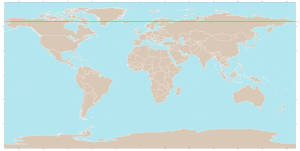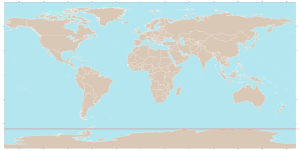Circle of latitude
This articleneeds additional citations forverification.(April 2012) |
 |
| Longitude(λ) |
|---|
| Lines of longitude appearverticalwith varying curvature in this projection, but are actually halves of great ellipses, with identical radii at a given latitude. |
| Latitude(φ) |
| Lines of latitude appearhorizontalwith varying curvature in this projection; but are actually circular with different radii. All locations with a given latitude are collectively referred to as acircle of latitude. |
|
|
| Geodesy |
|---|
 |


Acircle of latitudeorline of latitudeonEarthis an abstracteast–westsmall circleconnecting all locations around Earth (ignoringelevation) at a givenlatitudecoordinate line.
Circles of latitude are often calledparallelsbecause they areparallelto each other; that is, planes that contain any of these circles neverintersecteach other. A location's position along a circle of latitude is given by itslongitude.Circles of latitude are unlike circles of longitude, which are allgreat circleswith the centre of Earth in the middle, as the circles of latitude get smaller as the distance from theEquatorincreases. Their length can be calculated by a commonsineorcosinefunction. For example, the60th parallel northorsouthis half as long as the Equator (disregarding Earth's minorflatteningby 0.335%), stemming from.On theMercator projectionor on theGall-Peters projection,a circle of latitude is perpendicular to allmeridians.[1]On the ellipsoid or on spherical projection, all circles of latitude arerhumb lines,except the Equator.
The latitude of the circle is approximately theanglebetween the Equator and the circle, with the angle'svertexat Earth's centre. The Equator is at 0°, and theNorth PoleandSouth Poleare at 90° north and 90° south, respectively. The Equator is the longest circle of latitude and is the only circle of latitude which also is a great circle. As such, it is perpendicular to all meridians.
There are 89integral(wholedegree) circles of latitude between the Equator and thepolesin eachhemisphere,but these can be divided into more precise measurements of latitude, and are often represented as a decimal degree (e.g. 34.637° N) or withminutes and seconds(e.g. 22°14'26 "S).
On a map, the circles of latitude may or may not be parallel, and their spacing may vary, depending on whichprojectionis used to map the surface of the Earth onto a plane. On anequirectangular projection,centered on the equator, the circles of latitude are horizontal, parallel, and equally spaced. On other cylindrical and pseudocylindrical projections, the circles of latitude are horizontal and parallel, but may be spaced unevenly to give the map useful characteristics. For instance, on aMercator projectionthe circles of latitude are more widely spaced near the poles to preserve local scales and shapes, while on aGall–Peters projectionthe circles of latitude are spaced more closely near the poles so that comparisons of area will be accurate. On most non-cylindrical and non-pseudocylindrical projections, the circles of latitude are neither straight nor parallel.
Arcs of circles of latitude are sometimes used as boundaries between countries or regions where distinctive natural borders are lacking (such as in deserts), or when an artificial border is drawn as a "line on a map", which was made in massive scale during the 1884Berlin Conference,regarding huge parts of the African continent. North American nations and states have also mostly been created by straight lines, which are often parts of circles of latitudes. For instance, the northern border ofColoradois at41° Nwhile the southern border is at37° N.Roughly half the length of the border between theUnited StatesandCanadafollows49° N.
Major circles of latitude
[edit]
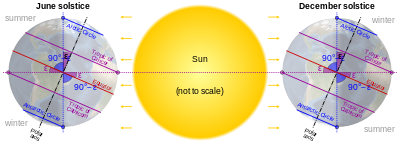
There are five major circles of latitude, listed below from north to south. The position of the Equator is fixed (90 degrees from Earth's axis of rotation) but the latitudes of the other circles depend on the tilt of this axis relative to the plane of Earth's orbit, and so are not perfectly fixed. The values below are for 14 September 2024:[2]
- Arctic Circle(66°33′50.1″ N)
- Tropic of Cancer(23°26′09.9″ N)
- Equator(0° latitude)
- Tropic of Capricorn(23°26′09.9″ S)
- Antarctic Circle(66°33′50.1″ S)
These circles of latitude, excluding the Equator, mark the divisions between the five principalgeographical zones.
Equator
[edit]The equator is the circle that is equidistant from theNorth PoleandSouth Pole.It divides the Earth into theNorthern Hemisphereand theSouthern Hemisphere.Of the parallels or circles of latitude, it is the longest, and the only 'great circle' (a circle on the surface of the Earth, centered on Earth's center). All the other parallels are smaller and centered only on Earth's axis.
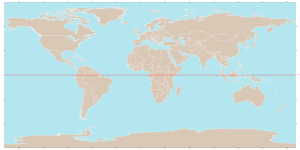
|
| Equator |
Polar circles
[edit]The Arctic Circle is the southernmost latitude in the Northern Hemisphere at which the Sun can remain continuously above or below the horizon for 24 hours (at theJuneandDecember solsticesrespectively). Similarly, the Antarctic Circle marks the northernmost latitude in the Southern Hemisphere at which the Sun can remain continuously above or below the horizon for 24 hours (at theDecemberandJune Solsticesrespectively).
The latitude of the polar circles is equal to 90° minus the Earth'saxial tilt.
|
|
Tropical circles
[edit]The Tropic of Cancer and Tropic of Capricorn mark the northernmost and southernmost latitudes at which the Sun may be seen directly overhead at theJune solsticeandDecember solsticerespectively.
The latitude of the tropical circles is equal to the Earth's axial tilt.
|
|
Movement of the Tropical and Polar Circles
[edit]By definition, the positions of theTropic of Cancer,Tropic of Capricorn,Arctic CircleandAntarctic Circleall depend on thetilt of the Earth's axisrelative to the plane of its orbit around the Sun (the "obliquity of the ecliptic" ). If the Earth were "upright" (its axis at right angles to the orbital plane) there would be no Arctic, Antarctic, or Tropical circles: at the poles the Sun would always circle along the horizon, and at the equator the Sun would always rise due east, pass directly overhead, and set due west.
The positions of the Tropical and Polar Circles are not fixed because the axial tilt changes slowly – a complex motion determined by the superimposition of many different cycles (some of which are described below) with short to very long periods. At noon of January 1st 2000 AD, the mean value of the tilt was 23° 26′ 21.406″ (according to IAU 2006, theory P03), the corresponding value being 23° 26′ 10.633 "at noon of January 1st 2023 AD.
The main long-term cycle causes the axial tilt to fluctuate between about 22.1° and 24.5° with a period of 41,000 years. Currently, theaveragevalue of the tilt is decreasing by about 0.468″ per year. As a result (approximately, and on average), the Tropical Circles are drifting towards the equator (and the Polar Circles towards the poles) by 15 m per year, and the area of theTropics,defined astronomically, is decreasing by 1,100 km2(420 sq mi) per year. (However, the tropical belt as defined based on atmospheric conditions is expanding due toglobal warming.[3])
The Earth's axial tilt has additional shorter-term variations due tonutation,of which the main term, with a period of 18.6 years, has anamplitudeof 9.2″ (corresponding to almost 300 m north and south).[4]There are many smaller terms, resulting in varying daily shifts of some metres in any direction.
Finally, the Earth's rotational axis is not exactly fixed in the Earth, but undergoes small fluctuations (on the order of 15 m) calledpolar motion,which have a small effect on the Tropics and Polar Circles and also on the Equator.
Short-term fluctuations over a matter of days do not directly affect the location of the extreme latitudes at which the Sun may appear directly overhead, or at which 24-hour day or night is possible, except when they actually occur at the time of the solstices. Rather, they cause a theoretical shifting of the parallels, that would occur if the given axis tilt were maintained throughout the year.
Other planets
[edit]These circles of latitude can be defined on other planets with axial inclinations relative to their orbital planes. Objects such asPlutowith tilt angles greater than 45 degrees will have the tropic circles closer to the poles and the polar circles closer to the equator.
Other notable parallels
[edit]A number of sub-national and internationalborderswere intended to be defined by, or are approximated by, parallels. Parallels make convenient borders in the northern hemisphere because astronomic latitude can be roughly measured (to within a few tens of metres) by sighting theNorth Star.
| Parallel | Description |
|---|---|
| 81°N | InSvalbard,Norway,the northern and southern limits of the area comprised by theSvalbard Treatyof 9 February 1920. |
| 74°N | |
| 70°N | OnVictoria Island,Canada, two sections of the border betweenNorthwest TerritoriesandNunavut. |
| 60°N | In Canada, the southern border ofYukonwith the northern border ofBritish Columbia;the southern border of Northwest Territories with the northern borders of British Columbia,AlbertaandSaskatchewan;and the southern border of mainland Nunavut with the northern border ofManitoba,leading to the expression "north of sixty" for the territories. |
| 54°40'N | The border between 19th century Russian territories to the north and conflicting American and British land claims in western North America. The conflicting claims led to theOregon boundary disputebetween Britain and the United States, giving rise to the slogan "Fifty-four forty or fight." |
| 52°N | In Canada, part of the border betweenNewfoundland and LabradorandQuebec. |
| 51°N | The southern limit ofRussian Americafrom 1799 to 1821. |
| 49°N | Much ofthe borderbetween Canada and the United States, from British Columbia to Manitoba; "49th parallel" is a common expression for the border, though the majority of Canada's population actually lives south of the parallel. |
| 48°N | In Canada, part of the border between Quebec andNew Brunswick. |
| 46°N | In the United States, part of the border betweenWashingtonandOregon. |
| 45°N | Approximates the portion of theCanada–United States borderbetweenQuebec(Canada) andNew YorkandVermont(US). Also approximates most of the border betweenMontanaandWyoming. |
| 43°30'N | In the US, the border betweenMinnesotaandIowa. |
| 43°N | In the US, much of the border betweenSouth DakotaandNebraska. |
| 42°30'N | In the US, the border betweenWisconsinandIllinois. |
| 42°N | Originally the northward limit ofNew Spain.In the US, the southern borders ofOregonandIdahowhere they meet the northern borders ofCalifornia,NevadaandUtah.The parallel also defines much of the border betweenPennsylvaniaandNew York. |
| 41°N | In the US, part of the border between Wyoming and Utah, the border between Wyoming andColorado,and part of the border between Nebraska and Colorado. |
| 40°N | In the US, the border between Nebraska andKansas.The parallel was originally chosen for theMason–Dixon line,but the line was moved several miles south to avoid bisecting the city ofPhiladelphia. |
| 38°N | The boundary between theSovietandAmericanoccupation zones in Korea, and later betweenNorth KoreaandSouth Korea,from 1945 until theKorean War(1950–1953). |
| 37°N | In the US, the southern border of Utah with the northern border ofArizona.The southern border of Colorado with the northern borders ofNew MexicoandOklahoma.The southern border of Kansas with the northern border of Oklahoma. |
| 36°30'N |  |
| 36°N | In the US, a short section of the border between theMissouri Bootheeland Arkansas. |
| 35°N | In the US, the southern border of Tennessee, which meetsMississippi,AlabamaandGeorgia.Also, part of the border between North Carolina and Georgia. |
| 33°N | In the US, the southern border of Arkansas, which meets the northern border ofLouisiana,is approximated by the parallel. Historically, it defined the southern border of theLouisiana Territory. |
| 32°N | In the US, part of the border between New Mexico and Texas. |
| 31°20'N | Part of the border between the US andMexico(SonoraandChihuahua); the southern border of Arizona and theNew Mexico Bootheel. |
| 31°N | Part of the border betweenIranandIraq.In the US, part of the border betweenMississippiandLouisiana,and part of the border betweenAlabamaandFlorida. |
| 28°N | In Mexico, the border betweenBaja CaliforniaandBaja California Sur. |
| 26°N | Part of the border betweenWestern Sahara(claimed byMorocco) andMauritania. |
| 25°N | Part of the border between Mauritania andMali. |
| 22°N | Much of the border betweenEgyptandSudan,partly disputed (see alsoHala'ib Triangle). |
| 20°N | A short section of the border betweenLibyaand Sudan, and within Sudan, the northern border of theDarfurregion. |
| 17°N | The division between Republic of Vietnam (South Vietnam) and Democratic Republic of Vietnam (North Vietnam) during theVietnam War. |
| 15°N | de factomaritime border betweenHondurasandNicaragua.[5] |
| 13°05'N | Part of the border betweenChadandCameroon,over a stretch of 41.6 km, partly inLake Chad |
| 10°N | Part of the border betweenGuineaandSierra Leone. |
| 8°N | Part of the border betweenSomaliaandEthiopia. |
| 1°N | Part of the border betweenEquatorial GuineaandGabon. |
| 1°S | Most of the border betweenUgandaandTanzania,and a very short section of the border betweenKenyaand Tanzania inLake Victoria. |
| 7°S | A short section of the border betweenDemocratic Republic of the CongoandAngola. |
| 8°S | Two short sections of the border between Democratic Republic of the Congo and Angola. |
| 10°S | A short section of the border betweenBrazilandPeru. |
| 13°S | Part of the border between Angola andZambia. |
| 16°S | Part of the border betweenMozambiqueandZimbabwe. |
| 22°S | A short section of the border betweenNamibiaandBotswana,and parts of the border betweenBoliviaandArgentina. |
| 26°S | InAustralia,the border betweenSouth Australiaand theNorthern Territory,and part of the border between South Australia andQueensland. |
| 28°S | In Argentina, the border betweenChaco ProvinceandSanta Fe Province. |
| 29°S | In Australia, much of the border between Queensland andNew South Wales. |
| 35°S | In Argentina, part of the border betweenCórdoba ProvinceandLa Pampa Province. |
| 36°S | In Argentina, part of the border betweenMendoza Provinceand La Pampa Province, and part of the border betweenSan Luis Provinceand La Pampa Province. |
| 42°S | In Argentina, the border betweenRío Negro ProvinceandChubut Province. |
| 46°S | In Argentina, the border between Chubut Province andSanta Cruz Province. |
| 52°S | Part of the border between Argentina andChile. |
| 60°S | The northern boundary ofAntarcticafor the purposes of theAntarctic Treaty System(seemap). The northern boundary of theSouthern Ocean. |
Elevation
[edit]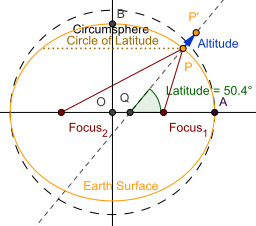
Normally the circles of latitude are defined at zeroelevation.Elevation has an effect on a location with respect to theplaneformed by a circle of latitude. Since (in thegeodetic system) altitude and depth are determined by thenormalto the Earth's surface, locations sharing the same latitude—but having different elevations (i.e., lying along this normal)—no longer lie within this plane. Rather, all points sharing the same latitude—but of varying elevation and longitude—occupy the surface of a truncatedconeformed by the rotation of this normal around the Earth's axis of rotation.
See also
[edit]References
[edit]- ^Kher, Aparna."What Are Longitudes and Latitudes?".timeanddate.com.RetrievedApril 15,2020.
- ^"Trópico en movimiento(in Spanish) ".RetrievedMay 13,2014.
- ^Quan, Xiao-Wei; Hoerling, Martin P.; Perlwitz, Judith; Diaz, Henry F.; Xu, Taiyi (March 1, 2014). "How Fast Are the Tropics Expanding?".Journal of Climate.27(5): 1999–2013.doi:10.1175/JCLI-D-13-00287.1.
- ^"Basics of Space Flight, Chapter 2".Jet Propulsion Laboratory.Jet Propulsion Laboratory/NASA. October 29, 2013.RetrievedMarch 26,2015.
- ^"Maritime Delimitation between Nicaragua and Honduras in the Caribbean Sea (Nicaragua v. Honduras)"(PDF).Archived fromthe original(PDF)on September 24, 2015.RetrievedMay 13,2014.
External links
[edit]- U.S. Naval Observatory – mean obliquity of the ecliptic.ArchivedOctober 12, 2007, at theWayback Machine.



